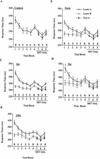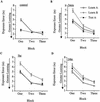Patterns of interference in sequence learning and prism adaptation inconsistent with the consolidation hypothesis
- PMID: 12359837
- PMCID: PMC187137
- DOI: 10.1101/lm.50102
Patterns of interference in sequence learning and prism adaptation inconsistent with the consolidation hypothesis
Abstract
The studies reported here used an interference paradigm to determine whether a long-term consolidation process (i.e., one lasting from several hours to days) occurs in the learning of two implicit motor skills, learning of a movement sequence and learning of a visuo-motor mapping. Subjects learned one skill and were tested on that skill 48 h later. Between the learning session and test session, some subjects trained on a second skill. The amount of time between the learning of the two skills varied for different subjects. In both the learning of a movement sequence and the learning of a visuo-motor mapping, we found that remote memories were susceptible to interference, but the passage of time did not afford protection from interference. These results are inconsistent with the long-term consolidation of these motor skills. A possible difference between these tasks and those that do show long-term consolidation is that the present tasks are not dynamic motor skills.
Figures






References
-
- Anderson MC, Bjork RA, Bjork EL. Remembering can cause forgetting: Retrieval dynamics in long-term memory. J Exper Psychol: Learn, Mem, and Cogn. 1994;20:1063–1087. - PubMed
-
- Bizzi E, Mussa-Ivaldi A. Toward a neurobiology of coordinate transformations. In: Gazzaniga MS, editor. The new cognitive neurosciences. Cambridge, MA: The MIT Press; 1999. pp. 489–500.
-
- Brainard MS, Doupe AJ. Interruption of a basal ganglia-forebrain circuit prevents plasticity of learned vocalizations. Nature. 2000;13:762–766. - PubMed
-
- Brashers-Krug T, Shadmehr R, Bizzi E. Consolidation in human motor memory. Nature. 1996;382:252–255. - PubMed
-
- Brooks DN, Baddeley AD. What can amnesic patients learn? Neuropsychologia. 1976;14:111–122. - PubMed
Publication types
MeSH terms
LinkOut - more resources
Full Text Sources
